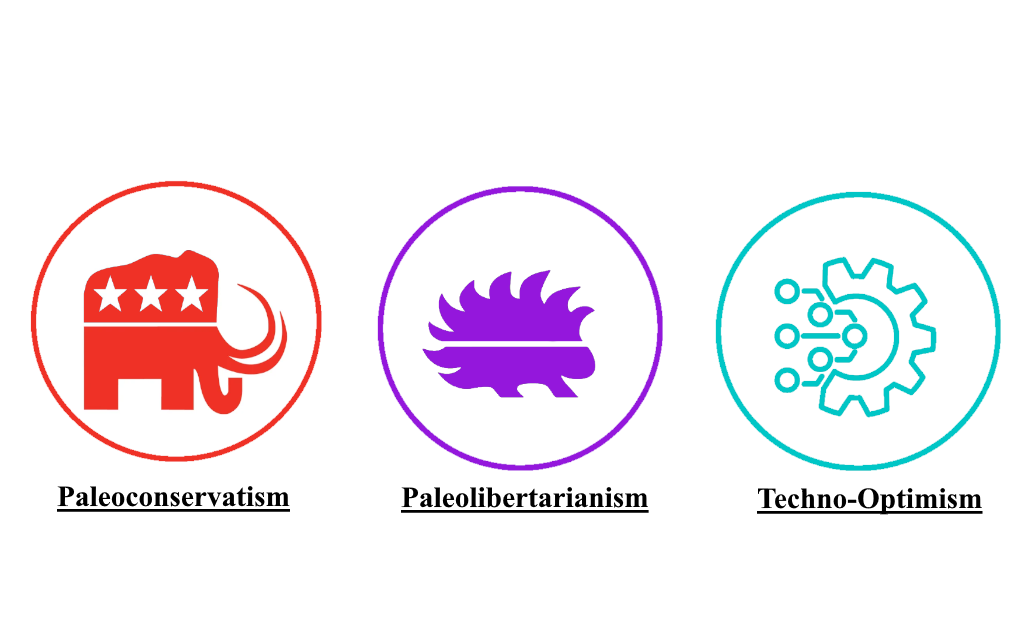Factions of the Rightosphere - Paleos and the Techno-Optimists
Paleoconservatives, Paleolibertarians, and Techno-Optimists.
The previous two articles were based around a broader grouping, Postliberalism and National Conservatism respectively. However, this article is less themed. It talks about two ‘Second New Right’ movements that survive to this day: Paleoconservatism and Paleolibertarianism, and a final Third New Right tendency, Techno-Optimism.
I make the distinction of ‘Second New Right’ because of history. These movements emerged in the 1980s and 1990s, the era of the Second New Right, and even formed a grouping called the ‘Paleo Alliance’ to resist mainstream conservatism. There is also some distance between them and Third New Right circles, today actually being closer to the ‘Dissident Right’ in many cases, as the Overton Window has changed.
This article will complete my discussion of the more mainstream tendencies, and in the next entry we will talk about the more explicitly ‘dissident’ movements.
Let’s jump in!
Paleoconservatives
Introduction
Paleoconservatives represent a reconstituted form of the ‘Old Right’ of William Howard Taft, his son Robert A. Taft, and Calvin Coolidge. They believe in limited government (but not laissez-faire or the absolutist ‘taxation is theft’ like Paleolibertarians), non-interventionist foreign policy, protectionist trade policy, state’s rights, and moral traditionalism.
They have a mixture of views on economics. The majority would support various economically interventionist policies, but on a subsidiarity-basis, being strong believers in the 10th Amendment and Originalism, and the idea of the federal government only intervening in tasks the states cannot do themselves. They are very socially conservative by modern standards, making no concessions to the LGBT rights movement.
History of Paleoconservatism
Russell Kirk, a major writer of National Review in its 1950s heyday, was the major inspiration for the Paleoconservative movement.
His work, most notably his masterpiece ‘The Conservative Mind’ (1953), de-emphasised a lot of the more propositional character of America, and focused on the continuity between the pre-independence colonies and the original constitution.
Kirk distrusted big government, but also big business, and his conservatism was rooted in localism and subsidiarity rather than libertarianism. It was on this localist basis that he defended the South, seeing Jim Crow as a ‘tradition’ which should not be violated. He also defended John C. Calhoun and John Randolph’s political theory of states rights and Compact Theory.
Living until 1994, in his old age Russell Kirk would go on to be a part of the movement he inspired, though he was never its leader. The leadership of Paleoconservatism would belong to two men, Paul Gottfried, who termed the label ‘Paleoconservative’, and Pat Buchanan.
Gottfried was the key intellectual, who in the middle of the 1980s sharply broke with the Conservative mainstream due to its support for Straussian, Neoconservative ideas. The tipping point had been the Mel Bradford Affair, after which, the Intercollegiate Studies Review and Philadelphia Society became some of the only conservative institutions that did not become controlled by the NeoCons. As an ethnic Jew, he represents the secular wing of Paleoconservatism.
Pat Buchanan is a Catholic, and represents the more ‘religious right’ inclined tendency. He was also the political frontman.
Buchanan was an establishment figure, having served in the Nixon and Reagan administrations, and having his own television show ‘Crossfire’ on CNN.
However, after the end of the Cold War, he became an opponent of the continuing presence of America abroad, wanting the United States to enjoy the ‘peace dividend’ instead of continuing to intervene in other countries where America had no direct interest. Unlike mainstream conservatives of that period, Pat Buchanan opposed free trade and globalisation, correctly predicting it would threaten the prosperity of the American working and middle-class.
He launched his Presidential campaign in 1992 against George H. W Bush for betraying his promise of ‘no new taxes’. Though he would ultimately lose to and endorse Bush Sr, he did better than many expected in the GOP primaries. At the 1992 Republican convention, Buchanan would make his historic, Cassandra-like speech, understanding the existential stakes of the culture war before most had even heard it.
Paleoconservative Origins and View of America
In many ways, the Paleoconservatives (Paleocons), an America-exclusive tendency, share many similarities with the National Conservatives of the various subgroups in the United States.
But crucial differences between Paleoconservatives and most American ‘National Conservatives’ include the conception of American national identity, the constitution, the legitimacy of Southern identity, states rights, and US relations with Israel.
Paleoconservatives see the United States as an extension of Anglo-Saxon civilisation, not as a propositional nation or a ‘nation of immigrants’. In their narrative, the American Revolutionary War was fought to protect the historic rights of Englishmen under the Magna Carta, not universal human equality.
Paleoconservatives tend to be very critical of the Declaration of Independence’s ‘All Men Are Created Equal’, although Gottfried does emphasise, when critiquing the Postliberal critique of liberalism, that this wasn’t the sole narrative of America and there were other competing ones, like that of the Antebellum South; they just lost, though it took a violent civil war to defeat them.
Alienation from Conservative Mainstream
The Paleoconservative refusal to totally denounce the history and culture of the Old South is one of the key things that makes them only barely respectable amongst National Conservatism types.
The default response of NatCons to Critical Race Theorists is to say ‘it was all the South’s fault’ and to bring up Abraham Lincoln as ‘The Great Emancipator’, with the Union victory proving that Whites are not inherently guilty of racism.
But Paleoconservatives don’t abide by the racism taboo, nor are willing to throw the South under the bus in defence of wider White America. They instead see a slippery slope, whereby attacks on the South end up being attacks on all of White America. They have a principled commitment to State’s Rights and the interests of Whites, that overrides commitment to racial equality.
Paleoconservatives on Israel
A major point of contention between Paleoconservatives and Neoconservatives historically is on the question of Israel. And the specific Paleocon orientation on this issue is quite distinctive compared to modern National Conservatives.
Most NatCons, even if they don’t believe in taxpayer-funded support for Israel, are well disposed towards Israel itself. Auron MacIntyre also has this view.
However, most Paleoconservatives have misgivings about the ‘Jewish lobby’, and the predominantly Jewish nature of Neoconservatism and Israel support; something noted even by Jews like Paul Gottfried.
The ‘Paleoconservative’ label is often defined as being antisemitic because some take ‘anti-Zionism’ beyond simply an ‘America First’ policy, and see Israel as a hostile force, in some cases actively supporting Palestine.
Paleoconservative Publications and Figures
If ‘The American Conservative’ represents a watered down, milder, more religiously conservative and therefore ‘safer’ form of Paleoconservatism, Chronicles Magazine is the original. It is more secular, but far more taboo when it comes to issues surrounding race and Southern heritage. Other publications include Intercollegiate Review, which is more academic and ‘respectable’, Taki’s Magazine, which leans more towards the White advocacy end, and The Imaginative Conservative, that is slightly more religious-traditionalist.
Notable Paleoconservative individuals include the late Samuel T. Francis (although he never liked the label ‘conservative’) Auron MacIntyre, Taki Theodoracopulos, Thomas Fleming, Clyde Wilson, Claes G. Ryn, William S. Lind and Pedro Gonzalez.
Conclusion
The Paleoconservatives are sort of the ‘bridge’ between the Third New Right and the Dissident Right. Having been vanquished from Conservatism Inc. (a term Paul Gottfried termed), at least until Trump when it was somewhat revived, a strong pessimism is impossible to ignore in Paleoconservative writings.
However, the ones reconstructing it, not just watering it down, are closer to the Dissident Right than the Third New Right.
Paleoconservatism has inspired both the 2010s Alt-Right and the 2020s Dissident Right. There is some argument about whether Nick Fuentes’ Groyper movement is a revival of Paleoconservatism, or its own movement. Many of the ideas of the Groypers have their roots in Paleoconservatism, despite being far more reliant on memes and humour as opposed to scholarly analysis. Nevertheless, Groyperism is distinct enough to warrant its own faction in this series.
Paleolibertarians
Introduction
Paleolibertarians subscribe to the Austrian School of Economics and champion laissez-faire, free banking, and sound money whilst opposing fiat currency. They have an absolutist view of property rights, seeing taxation inherently as ‘theft’ and even when they aren’t Anarcho-Capitalists, see the state, at best, as a necessary evil. They place a strong emphasis on the Non-Aggression Principle (NAP) as the core means of operating society.
Notable Paleolibertarians include Murray Rothbard, Lew Rockwell, Hans-Hermann Hoppe, Ron Paul, Tho Bishop, Javier Milei, Catgirl Kulak/Anarchonormiecon, and Radical Liberation. Organisations espousing Paleolibertarianism include the Mises Institute and the Mises Caucus (Libertarian Party).
The Paleolibertarians hate mainstream Libertarians like the CATO Institute and Reason as much as Paleoconservatives, seeing them as agents of the regime and not true libertarians. They emphasise that libertarianism does not mean social permissiveness, indeed Hoppe, in ‘Democracy: The God That Failed’ (2001) talks about ‘Covenant Communities’ with the right to expel ‘deviants’.
Paleolibertarians, even people like Ron Paul who did this before it was more accepted, very much emphasise free association, and how Title II and Title VII of the 1964 Civil Rights Act completely ended it; something that mainstream ‘socially liberal and fiscally conservative’ libertarians would be aghast by.
This faction was dormant for a while, as in the late 2010s most of the ‘Third New Right’ blamed libertarians for the modern conservative movement’s sell-out on the culture war, and being inherently passive in the face of Wokeism.
However, Nayib Bukele in El-Salvador and Javier Milei in Argentina have led to something of a resurgence in the last year in the Anglosphere, and it is up in the air where this could lead.
Differences Between Paleoconservatives and Paleolibertarians
The key differences with Paleoconservatives are economics and the role of the state.
Paleoconservatives see a role for the state as promoting the common good, even at the smallest possible level as they are distrustful of big government. They see taxes as, whilst they should be as low and as locally raised as possible, as part of civilisation, as they understand human beings have always lived in groups. To Paleocons, the state has various important functions, for instance through policing, defence, and the building of infrastructure, even if it should be minimal and the ‘common good’ involves a large amount of individual freedom. As mentioned previously, they fundamentally reject the doctrine of ‘natural rights’ that animated the Declaration of Independence and John Locke.
Paleolibertarians strongly disagree with all of this. They take the ‘natural rights’ discourse to the extreme, though in a very different way to the Claremonters, echoing Ralph Waldo Emerson, Henry David Thoreau, and Lysander Spooner in their belief that the ‘Social Contract’ literally means a ‘contract’ that any individual can opt-out of. They see those figures as a precursor to Anarcho-Capitalism, which not all of them subscribe to but are at least adjacent to. Paleolibertarians believe taxation to be theft, and even when it does exist, see it as a necessary evil (aka, Hans Hermann Hoppe) rather than morally neutral depending on the type, the amount, how it’s spent (Paleoconservatives).
On economics, the main sticking point is tariffs, with virtually all Paleoconservatives supporting strong tariffs and virtually all Paleolibertarians embracing free trade. Most Paleolibertarians will also reject anti-trust measures, whilst Paleoconservatives, in the tradition of figures like William Howard Taft, think that sometimes this is justified. When it comes to Lochner vs New York (1905), Paleoconservatives reject it as they put states rights above private property rights, whereas most Paleolibertarians support it as they put private property rights above states rights.
Paleoconservatives tend to like Glass-Steagall and the Federal Deposit Insurance Corporation, even if they oppose most of the New Deal, whilst Paleolibertarians want to abolish the Federal Reserve entirely, which some Paleoconservatives do but it’s not a major issue for them.
Techno-Optimists
So this faction is somewhat a construction of myself, and a grouping of various writers who I think touch upon similar themes. The person who termed the word ‘Techno-Optimist’ was Marc Andressen, who wrote the ‘Techno-Optimist Manifesto’. Other names are Techno-Commercialist, Effective Accelerationist (e/acc), Tech-Right, and even ‘Right-Wing Progressive’.
Some other people I would place in this category are Richard Hanania, Peter Thiel, Brian Chau, Robin Hanson, Ruxandra Teslo, Maxwell Tabarrok, and Elon Musk (not a political theorist but a major leader of this movement). There are many more ‘centrist’ advocates of this techno-optimist approach like Noah Smith, but I wouldn’t really include them here as this series is focused on the ‘Rightosphere’. There are no formal ‘Techno-Optimist’ publications, aside from the individual Substacks.
These people have different views on various issues. Thiel has been an outspoken opponent of democracy and was Curtis Yarvin’s chief patron, whereas Richard Hanania likes the deceptive elitism of current liberal democracy, and Musk has claimed to support direct democracy.
What unites them all is a dislike of the left’s suspicion of innovation and technological progress, and it putting ‘diversity, equity, and inclusion’ above a Faustian desire for innovation and expansion. Being highly overrepresented among the tech elite, with Andressen, Thiel, and of course Musk being billionaires themselves, they seek to create a more rigorously ‘capitalist’ society. This usually manifests in an ideal of a neo-Fordist economic order, where tech-barons like themselves are able to shape the world in their image, and a ‘purer’ meritocracy, with no concern for unequal group outcomes.
This faction is globalist-inclined. They desire free trade, and at least a functioning legal immigration system; not liking illegal immigration but desiring more legal immigration. They support technology like cryptocurrency and seasteading to be able to escape draconian government regulation that they see as holding back progress. And they celebrate traditional neoliberal thinkers like Adam Smith and Friedrich Hayek. Virtually all of this faction will be inspired, to a greater or lesser degree, by Nietzscheanism.
They see other factions of the right, with their inherent distrust of innovation, as just as suspicious as those on the left. Hanania in particular is loudly and proudly pro-abortion, and frequently condemns the backwardness and ‘slave morality’ of the pro-life crowd. To him, it is a barrier to creating a eugenicist society. He also is unconcerned with the issue of immigration, liking it when it undermines the power of trade unions. He is part of this sphere mainly for his very well made critiques and analysis of Wokeism, notably its origins in Civil Rights Law and feminisation of public life.
In conclusion, whilst many on the right will dislike this group for not being focused on demographics enough, and indeed in their black-pilled way see the support of tech-billionaires as a betrayal or co-option of the cause, this faction is an important one as it has the ear of some very powerful people.
Conclusion
Whilst this entry was less themed than the last two, I hope you still enjoyed it. As has become a common recurrence, I would welcome any corrections from those who know these movements better than I do or who are themselves mentioned.
Thanks for reading, and if you enjoyed this article, please subscribe.
Click here for the next entry, on the Dissident Right.








Hanania is a troll who will say whatever will get most clicks. Anatoly Karlin never had an original idea in his life. Started as a Bay Area rationalist, tried to do some HBD analysys, then went unhinged russian ultranationalist. I have no idea what he is doing now as I stopped paying attention to him years ago.
Libertarianism is dead because it obsessed about preserving freedom by limiting state power and defending strong property rights only for the woke cultural revolution to take over businesses and NGOs even faster then it did public institutions.
As someone who is paleolibertarian adjacent, it might be worth addressing their general approval of national divorce/secession as well as nullification. Given paleocons view on the south and the civil war, I'm not sure where they stand on secession today, but I am quite confident that paleolibs are in support of a more decentralized approach to politics across the board — not quite the same as subsidiarity because it is characterized by an opposition to high-level decision making as opposed to just a predilection towards low-level decision making.
And as a point of contrast between paleolibs and paleocons, you could point out that paleolibs take the notion of "states' rights" to its logical conclusion by privileging the decisions of smaller states over those of larger ones encompassing them. I don't say this to "dunk" on paleocons, just to point out that libertarians in general are more autistic about their principles, but it could very well be that there is something about certain arbitrary arrangements that just works for some reason which conservatives make an effort to distill.
Lastly, while a lot of Chicago economists are more alike to the Cato or Reason types of libertarian, their economic theory does seem to be a bit more robust due to its more quantitative nature. As someone who started with Austrian economics, I'm sure they will object to this because they think the subjectivity of human action makes quantification impossible, but I think Bryan Caplan made a convincing argument against this. Plus, those who haven't done serious math (I come from a pure math background) can't quite comprehend just how tricky rigorous reasoning can be in the absence of quantitative measures to act as falsifying methods. That's not to say the Austrian tradition isn't valuable; it still informs how I perceive the world, but I would say it's more ideological than the Chicago school. This ideological bent makes it excellent for binding groups together, and Hoppe has some worthwhile takes regarding strategy, but I understand also why many intellectuals would be turned off by its virtual anti-empiricism. That said, it is very strong where economic history and political economy are concerned, so one could make an argument that the Austrian school is the "right brain" to the Chicago school's "left brain" in true McGilchrist fashion. Still, David D. Friedman is very much worth reading as he gives models of anarcho-capitalism which are consequentialist in nature instead of deontological.